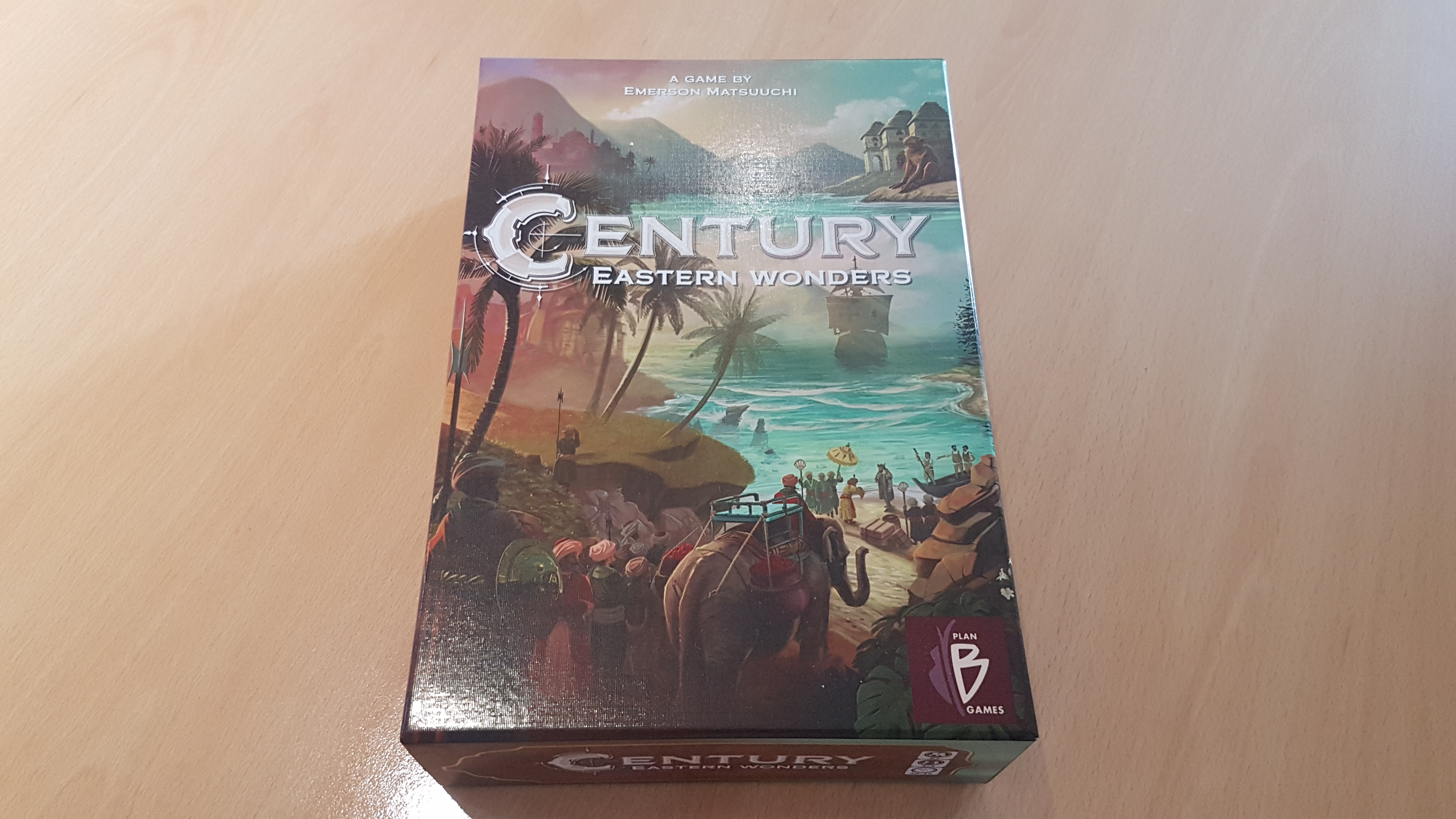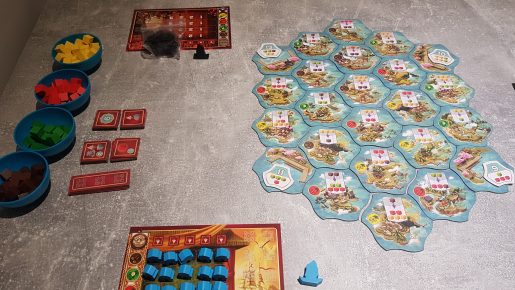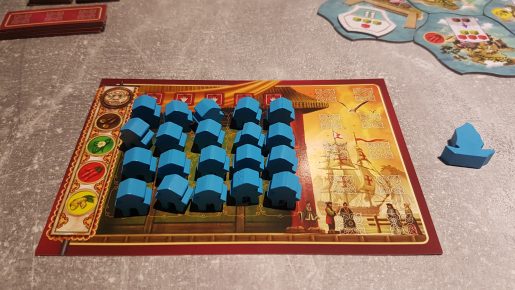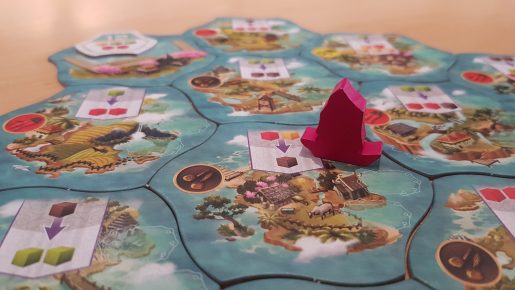Century Eastern Wonders is the second board game in the Century trilogy from designer Emerson Matsuuchi. Published by Plan B Games, this is a pick up and deliver, set collection board game, which sees 2 – 4 players sail between islands, trade with markets and deliver cargo for points. In an interesting twist Eastern Wonders also combines with the original Century Spice Road, to play as From Sand To Sea, which will also be briefly touched upon. However, is the second game in the trilogy worth playing or were the best elements in the original? Let’s find out!
In Eastern Wonders players start out with an empty boat, a randomly built tile based map in front of them and the information of what the four ports require to claim victory point (VP) tokens. In reverse player order everyone gets to take one of four starting cargo loads and select a starting location on the board. The general aim of the game is slowly but surely trade resources for other types to complete orders. There are 4 types of resources, represented by cubes: yellow ginger, red chillies, green tea and brown cloves. Gamers can interpret their worth as increasing from yellow to brown, due to it being harder to gain the latter cubes.
There are two types of locations, with 4 ports and 20 market islands make up the game board – leaving 4 market tiles in the box. Each island has a unique market trade that offers players the chance to change the designated cubes into another type. They also have a denoted trade symbol, one of the four types, with one of each type making up the four removed tiles to keep balance.
On a turn a player may move to an adjacent market tile for free: though movement is not mandatory it must be done as the first part of a turn. Players during their move can decide to continue to move to adjacent spaces by leaving behind a cube from their cargo hold. After this, players can then perform one of three actions. The basic action that is a great guarantee that everyone will do something each turn is harvest, seeing the player gain 2 yellow ginger cubes. It is key, when teaching Eastern Wonders, to explain that the trade symbols on tiles do not affect what is gained via harvesting.
Instead of harvesting players can decide to take a market action. This is a two stage process with players first having to build, or have previously built, an outpost on that market island. For whomever is the first to build on a market tile construction is free, for each outpost built by others on the tile the cube cost rises by 1. Once built a player can utilize the denoted trade action as part of the market action, as with Spice Road these trades can be used as many times as the player can afford. For example, using a trade offering 2 green for 3 yellow cubes the player could trade 6 yellow for 4 green, doing the trade twice.
Outposts are not just in the game to allow players to trade at market islands. As they get placed from the player’s board they can uncover victory points. On top of this, clearing an entire column from the player board, one on each market tile type, a bonus is awarded. These bonuses are strong so should not be overlooked, including: the ability to move an additional tile for free each turn, straight up victory points (the amount decreases as tiles are taken), a 3 cube cargo expansion, the ability to instantly upgrade a cube two times plus two victory points, and an upgrade to the harvest action that sees the player obtain a red cube (in addition to the two yellow cubes). Note, the latter two are only used in Eastern Wonders, being removed for From Sand to Sea.
The final action is only available at a port. From trading via the market action and harvesting players will have built up their cargo; note that each player can only hold 10 cubes at one time by default. By getting to a port a player can effectively sell the cubes they have, by delivering the cube requirements on the VP token at the port. Points range from 9 to 20, so there can be a large disparity between their requirements.
Whenever a VP token is claimed a new one is drawn from the pile to replace it. One tile which is shuffled into the top of the pile features only an X which denoted that the port is temporarily closed, until another port gets delivered to which the X token gets moved to. This means the “objectives” are dynamic and change throughout the game. Whenever someone has claimed their 4th VP token the game ends at the conclusion of that round.
Players then calculate their final scores; taking into account the VP tokens they claimed, points earnt from bonus tiles, points revealed from built outposts and interestingly gaining a point per non-yellow cube in their cargo hold. This last element helps players whom are just turns away from claiming a VP token, through from the points return it is always better to have got a VP token. The player with the highest points wins, with ties won by whoever is behind in the turn order.
When playing with only two players constructing as many outposts as possible becomes more of a viable strategy than with other player counts. As usual getting outposts down has multiple advantages above being able to do the trades: bonus tiles and bonus points. On top of this if you are consistently able to get outposts down first the cost of being the second player (2 cubes per outpost in a 2 player game) certainly builds up fast. In a 4 player game this cost can be higher but it seems to often be more balanced across all players.
Spice Road and the Golem Edition both had fantastic artwork adorning the cards, something missing from Eastern Wonders. This being said the production quality has not slipped, instead it has morphed to create a wonderful map of islands on the table, despite the rather odd tile shapes. Aside from similarities each market island has its own artwork, they have enough room on them to house the colourful wooden outposts and the players boats; all whilst allowing the tile information of trades and type to be visible. The outposts might be a little fiddly for those with larger fingers but the way they brighten the map makes up for this.
The gameplay has transitioned well from a card game to a pick up and deliver style title. It shakes things up being able to see all the potential trade options from the beginning of the game. Also, it is nice not having opponents being able to permanently block you from a trade, with just the cost of building an outpost stopping you. The speed of the game is helped by the ability to jettison cargo for the sake of additional movement and this helps players jump around the map; whilst working out optimal routes, similar to determining the optimal card combinations of the original.
From Sand To Sea is where the design of the Century trilogy gets interesting. Aside from being great games separately Eastern Wonders comes with rules to combine the first two games of the series. Removing a few of the trade locations, replacing them with empty sea locations the board is simply transformed. These sea tiles are great at breaking up the island filled landscape, so much so I even include them occasionally when building custom maps for both variants. Next the Merchant cards from Spice Road are added into the mix, with players starting with the original two starting cards. Instead of moving and performing the usual Eastern Wonder actions, players can decide to play a card from their hand or make a purchase, in the Spice Road way, from a reduced market.
Player sheets are also changed from the versions used in Eastern Wonders, flipping over to reveal fewer spaces for outposts, and altered bonuses. Two bonus tile types are removed from the bonus pool options, but players can instead grab a merchant card for free. It’s a nice way to further include the cards, even if the option isn’t always used. Due to the core logic of trades being consistent between the two games they do fit together, almost like puzzle pieces, giving players more choices to think about. Other than these changes the objectives of gathering resources and delivering them is unchanged from the Eastern Wonders ruleset. I’d certainly suggest getting a couple of games of both played games separately with new players before dabbling with From Sand To Sea. If you don’t gamers tend to neglect one avenue and suffer points and progression wise as a result.
Century Eastern Wonders takes the core processes seen in Spice Road and successfully makes the transition from card play to pick up and delivery style gameplay. Players get to plan their route out over a much more visually attractive game, with the same standard – if not better – components. Due to the bonus tiles on the surface there seems to be more choice open to players but the same couple (additional movement and harvest bonus) often get snapped up first. It is an intriguing concept to be able to merge Century Eastern Wonders with Spice Road, to form From Sand To Sea. Alas, while enjoyable, the clear waters of simplicity of both titles is somewhat left murky. Nevertheless, be it from the visual draw of the game or the gameplay even the humble, loved and respected Spice Road will struggle to get back to my table over Eastern Wonders in the future.
[Editor’s Note: Century Eastern Wonders was provided to us by Asmodee UK for review purposes. The game is currently available on 365 Games for £32.99. It is also available from local UK board game stores, find your local store here]





